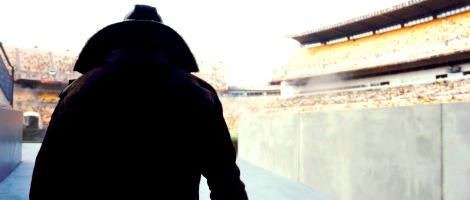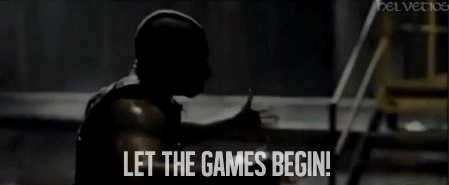For the most part, this was almost like a fifth preseason game. The Steelers certainly played like it with vanilla play-calling on offense. Tennessee is a team with an old school run the ball and play defense attitude and that’s exactly what they did. The Steelers kept Chris Johnson contained, giving up only 70 yards on 25 carries with a long of only 11 yards. Johnson was held to just 2.8 yards per carry and that number drops under 2.5 if you take out the one 11-yard run.
The game started about as good as one could hope with Tennessee nullifying their coin toss win with a bonehead mistake on the kick return where Darius Reynaud fielded the ball, stepped back into the end zone and took a knee for a safety.
The Steelers came out with Beachum at tight end and went play-action on the first play. Ben tried to hit Sanders deep and the ball went right through Manny’s hands. It wasn’t an easy catch to make, but that’s the kind of play that the Steelers need to hit on this season. That was the only deep shot of the first half, mainly because of what happened next. On the only outside zone play of the game, DeCastro launches right into Pouncey’s knee. It was bad. You knew it was bad. Everyone knew it was bad. Pouncey was carted off and the team was never the same.
One of the biggest problems with the game as a whole was the coaching. There was a game plan that involved Beachum playing as TE on running plays and no backup plan. The problem with that is since Beachum was the top backup at every position on the offensive line, there should have been some kind of backup plan in case anyone on the offensive line got injured. As it happened, Pouncey’s injury forced Beachum to move to center and the Steelers acted like they just lit their playbooks on fire.
The coaching mishaps continued on a 3rd and 1 play at the Tennessee 6. Felix Jones was supposed to come in but didn’t make it off the sideline in time and tried to run out onto the field with 10 seconds left on the play clock and the offense breaking the huddle. There was obvious confusion and with David Johnson lined up at tailback and Isaac Redman at fullback, the defense had to be cued in to a nontraditional play. Rather than calling a timeout from the sideline, which Tomlin is allowed to do, he let the play go off, which resulted in Redman fumbling and Tennessee recovering. Regardless of the result of the play, it was a terrible coaching move not to take a timeout. It was a third down play inside the opponents 10 yard line. With a backup center and the wrong personnel in the game, it’s inexplicable that the coaches let the play go off with the play clock winding down.
To make matters worse, Tomlin carried all 3 of his first half timeouts into the half. Tomlin’s clock management got even worse as the game progressed. It’s hard to believe that one of the worst clock managers in the league could have gotten worse, but it seems as though Tomlin has regressed in the offseason. He is like the Mark Sanchez of clock management.
Let’s fast forward for a moment to the end of the game. With the Steelers trailing 16-2 (yes, this was an actual score in this game) after surrendering a field goal to the Titans with 4 minutes to play, Ben led the team down the field in 5 plays. However, none of those 5 plays were sideline routes or spikes, so almost 2 minutes ran off the clock. On 2nd down from the Tennessee 11, Ben hit Redman out of the backfield who was brought down at the Titans 4. Rather than letting 2 seconds tick off the clock, Tomlin used his last timeout with 2:02 remaining. This was mind-bogglingly bad. Twelve-year-olds playing Madden don’t make this mistake.
The Steelers were down by two touchdowns. They needed a score and an onsides kick. The assumption with the timeout was that they could score before the two-minute warning because it would get them an extra play. But this extra play wasn’t needed. If you know you need to throw for the end zone, letting the clock hit two minutes was the better choice because it preserved your chance at victory rather than putting the onus on the onsides kick. If the Steelers go to the 2 minute warning with 1 timeout left and score on the first play afterwards, we can assume 5 seconds come off the clock. The Steelers would then attempt an onsides kick with 1:55 remaining and 1 timeout. If Tennessee recovers, they could run a play with the last timeout afterwards (1:50 remaining). The Titans could then run the ball two more times and assuming the defense would stop them, 80 seconds would run off the clock. The Titans would be punting back to the Steelers with about 30 seconds remaining. This would give the Steelers a chance – albeit a long one – to complete a sideline pass to get in position for a Hail Mary. As it was, the entire onus of the game rested on the onsides kick because the Steelers used their last timeout. When the Titans recovered the onsides kick, the game was over.
It also didn’t help that with first and goal from the 4, Ben threw exactly zero passes into the end zone on four downs. There was a completion to Redman on a third down where he gained a yard and his touchdown pass to Cotchery was caught right at the goal line. This gets back to play-calling and situational football. The Steelers needed a touchdown and needed one fast, yet they didn’t throw the ball into the end zone once. They got the touchdown to make things interesting, but it didn’t come until fourth down and after a completed pass where Redman was tackled in bounds that resulted in 30 seconds coming off the clock.
There was very little about this game that was confidence-inspiring. The Steelers got beat in the trenches on both sides of the ball. The offensive line was terrible without Pouncey and the Titans defensive line had their way with the Steelers. Ben was sacked 5 times and had no time to set up in the pocket to even get the ball to a receiver. Without Pouncey anchoring the middle, Beachum was getting pushed back into Ben’s lap, taking away Ben’s ability to step into his throws, which resulted in some ducks being tossed around. On the other side of the ball, the defensive line got a good push but couldn’t get off blocks and make meaningful plays in the backfield. The Titans were able to run the ball in the old school “Three Yards and a Cloud of Dust” style of football.
When it came down to it, even though the numbers looked good, the Steelers defense didn’t make the key plays necessary for the team to win. Tennessee engineered a 12-play, 49-yard drive that ate almost 7 minutes off the clock and resulted in a touchdown. The Steelers had the opportunity to stop the drive when Mike Munchak decided to go for it on 4th and 1 from the 26. Larry Foote and Lawrence Timmons both got penetration, but Jackie Battle worked his way through and picked up the first down.
The Titans offense didn’t do much aside from the touchdown drive, but they dominated the field position game for much of the afternoon and kept the Steelers pinned back into their own end. The difference in average starting position was staggering, with the Steelers average start at their own 19 and the Titans average start at their own 40. Tennessee utilized the shorter fields and a good punt return to add three field goals, which was enough for them to secure victory. Though the Steelers only gave up 229 total yards and holding the Titans to 6-for-15 on third downs, Tennessee averaged 6.6 plays and 22.9 yards per drive. Coupled with the excellent field position they enjoyed all afternoon, the Steelers defense had to play with their backs against a wall the whole game.
Once again, the Steelers lost the turnover battle. In addition to Redman’s fumble, Ben threw an interception where he tried to force a ball to Sanders across the middle. The Steelers had their opportunities, with Troy Polamalu almost making a patented diving interception off a tipped ball and failing to come up with a Delanie Walker fumble in the secondary. Additionally, William Gay made a second pass deflection that he tipped into the air and it fell harmlessly to the ground. Both Steelers turnovers and the two near turnovers all directly related to the outcome of the game. Redman’s fumble came on a 3rd down inside the 5, and the Steelers would have at least added a field goal there. Ben’s interception gave Tennessee the ball at midfield where they started their only touchdown drive. Troy’s near-interception was in Tennessee territory and would have set up the Steelers in field goal range. The Walker fumble occurred in Steelers territory and Tennessee kicked a field goal after retaining possession.
When the dust settled, Tennessee walked off the Heinz Field turf with a victory and the Steelers left with five injuries. Three players – Pouncey, Larry Foote and LaRod Stephens-Howling – were lost for the season. Foote suffered a ruptured biceps that could be a career-threatening injury (Aaron Smith was never the same after he suffered a similar injury in his mid-30s). LaRod suffered a torn ACL, which was strange because he returned to the huddle, went to the ground and was then able to hobble off the field. Additionally, Cortez Allen sprained his ankle which forced Will Gay into 3-down action in the second half and brought in rookie Shamarko Thomas as the nickel back. Kicker Shaun Suisham pulled a hamstring in warmups and managed a squibbed opening kickoff and converted an extra point late in the game.
This was not a good Tennessee team that the Steelers lost to, and the outlook for the future isn’t much better. They have to travel to Cincinnati on Monday night then come back and play Chicago on Sunday night. Both of those teams are better on offense and better on defense than Tennessee, and it is entirely possible that with another offensive performance like this the Steelers will suffer their worst primetime embarrassment since they lost 9-0 to Jacksonville in 2006 and didn’t even get past midfield. The Steelers were not a deep team and were not a team that could afford to suffer injuries. The injuries were compounded by bad coaching decisions – starting with Tomlin’s decision to dress 5 wide receivers (Derek Moye only saw the field for 2 offensive snaps and 3 special teams plays) instead of an 8th offensive lineman (which would have been Cody Wallace, their backup G/C). Beachum was still the top backup at every OL position, but having Wallace dressed would have given more of a cushion if any other injuries occurred on the line. Having Wallace also would have given them one player on the sideline that had played more than zero snaps at center in a regular season game.
Moving forward, the Steelers placed Pouncey, Foote and Stephens-Howling on Injured Reserve and signed former Titans center Fernando Velasco and journeyman kicker Shayne Graham. Velasco will compete with Beachum for the starting center spot this week, but gives the Steelers a player with NFL experience in the middle. Graham may be released later in the week if Suisham’s leg is good enough to kick on Monday night. This would open the door for the Steelers to sign another inside linebacker, presumably Stevenson Sylvester (who is a free agent) or Marshall McFadden (who is on the Raiders practice squad). They also brought back Jonathan Dwyer to help fill the void at running back because Le’Veon Bell is out for this week against the Bengals.
Looking ahead, we are one game into a 16-game season. Everyone else in the AFC North lost this weekend. The Steelers problem now is not that they are old and slow. It is that they are young and inexperienced. The Steelers have the look of a team that will finish in the bottom half of the league once again this season. But do not give in to the fear just yet. There may come a time for panic, say – if the Steelers board a plane for London with an 0-3 record, but that time is not yet. A win against the Bengals would cure a lot of ills, but the Bengals are also a much better team than this Titans bunch that held the Steelers to only 1 third down conversion over the last 55 minutes of the game (none in the second half) and stifled the Steelers offense with 4 3-and-outs in six second-half drives.
Add The Sports Daily to your Google News Feed!







